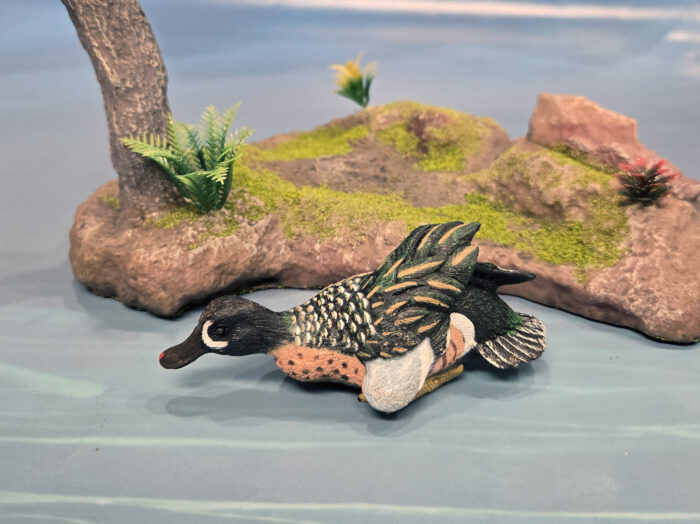Despite sharing the common name ‘teal’, the Blue-winged Teal (BWTE, Spatula discors) is not in the same genus (Anas) as the Green-winged Teal (GWTE) from my earlier review, although it was for a period. The genus Spatula, originally described in 1822 and eventually placed in synonymy with Anas, was resurrected in 2009 after a molecular phylogeny looking at two mitochondrial genes (cytochrome b and the NADH dehydrogenase subunit 2) determined Anas to be non-monophyletic.
Green-winged Teal (Large Ducks by AAA)
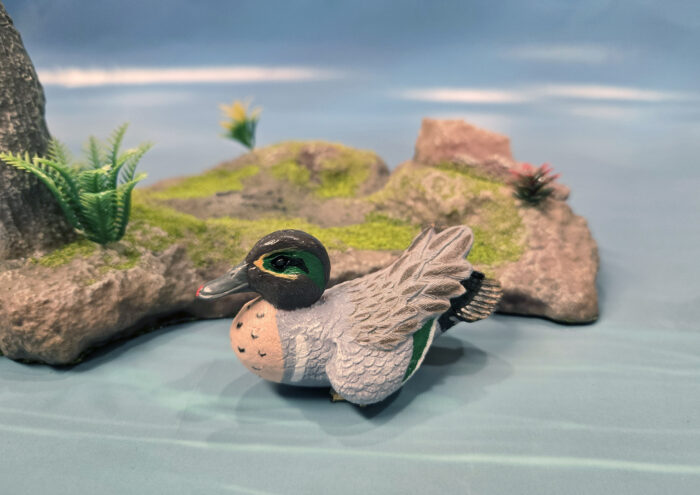
The Green-winged Teal (Anas crecca) is a small dabbling duck that occurs throughout much of the Northern Hemisphere. Historically, the American populations were classified as either a subspecies of the Eurasian teal (A. crecca carolinensis) or as a valid species (A. carolinensis), but now the American and Eurasian populations are lumped into one widespread species.
Bluegill, Pumpkinseed, Crappie (3″ Pond Fish set Part 2 by Replica Toy Fish)

And here we have the final trio of the original 3″ fish produced by Replica Toy fish, the second half from the ‘pond fish’ set. Similar to my look at the two halves of the American Angler set (here and here), the first Pond Fish set featured a range of taxonomic groups, and this second half will be all from a single family–Centrarchidae, the basses and sunfish.
Largemouth Bass, Channel Catfish, Yellow Perch (3″ Pond Fish set Part 1 by Replica Toy Fish)

Back with another trio from the original dozen three inch fish released by Replica Toy Fish. When packaged in the small acrylic tubes, it was referred to as the ‘Pond Fish’ set. While the ‘Northwoods’ set featured popular angling fish found primarily in northern North America, the next six are normally considered more southern in their natural distribution–but as with any popular sport fish, they’ve found themselves spread, legally or not, into many other regions of North America and the world.
Monarch Butterfly, caterpillar (Hidden Kingdom Smithsonian Insects by Safari Ltd.)

In following the trends of Safari Ltd.’s Tennessee Aquarium Salamander, Monterey Bay Aquarium, and Marsh Education Fish collections, I am going to attempt to finish, or assist in finishing, Safari’s Hidden Kingdom Smithsonian Insects collection (the lubber grasshopper, black widow, and flea have already been reviewed). If I remember correctly, the figures were originally produced by Safari in the late 1990s alongside a traveling museum exhibit sponsored by the Smithsonian Institution that featured large animatronic insects.
Star-nosed Mole (The Mysteries of Living Things Encyclopedia by Takara Tomy A.R.T.S.)

The star-nosed mole (Condylura cristata) is an animal that has amazed me since childhood, and not unlike the osprey of my last review, a species I always wanted a figure of. I am genuinely surprised it took this long for one to be produced. Maybe there have been others, I am not privy to every animal figure or toy produced throughout history, but today’s 2024 model by Takara Tomy A.R.T.S.
Northern Pike, Muskellunge, Tiger Muskie (3 Inch Northwoods Fish set Part 2 by Replica Toy Fish)

I’m back with the second half of the Northwoods set from Replica Toy Fish. I looked at the other three species here, and now I’ll look at the other three, also three popular sport fish in more northern areas of North America (one of which is naturally found more broadly). The species today are all in the family Esocidae, the pikes: the muskellunge Esox masquinongy, the northern pike Esox lucius, and the tiger muskie Esox masquinongy x lucius (a hybrid of the northern pike and muskellunge).
Caribou (Wild Safari North American Wildlife by Safari Ltd.)
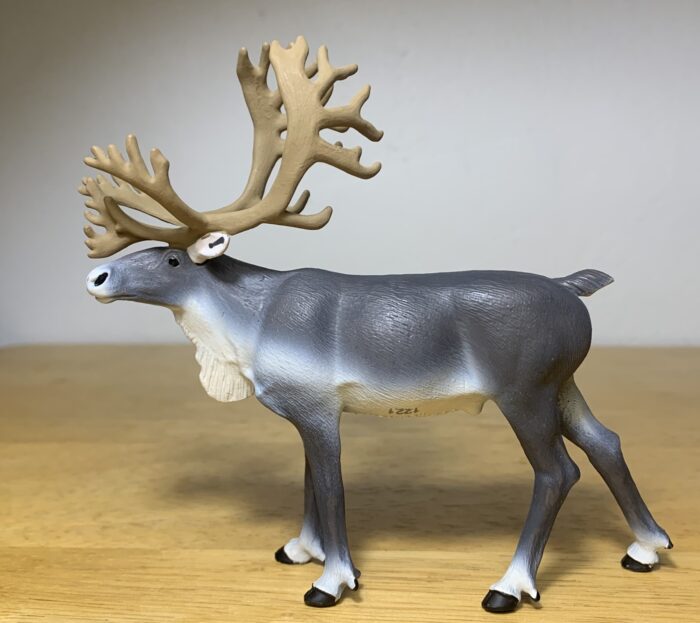
A few years ago, I reviewed the CollectA woodland caribou for the holiday season and since I’m a one-figure-per-species collector I thought I would be done with caribou aka reindeer after that. But here I am again with another figure of the same species, again for the holiday season. Why? Well, I got this idea in my head that for Rangifer tarandus I might want to collect some of its many subspecies.
Tiger Muskie (6 Inch Series by Replica Toy Fish)

And another six inch figure from Replica Toy Fish. This time it’s a hybrid species, the tiger muskellunge or tiger muskie, Esox lucius x masquinongy or Esox masquinongy x lucius (it depends on on which the male is, indicated first). The tiger muskie, as indicated by the species name, is a hybrid animal animal with northern pike and muskellunge parents, and are usually sterile.
Northern Pike (6 Inch Series by Replica Toy Fish)
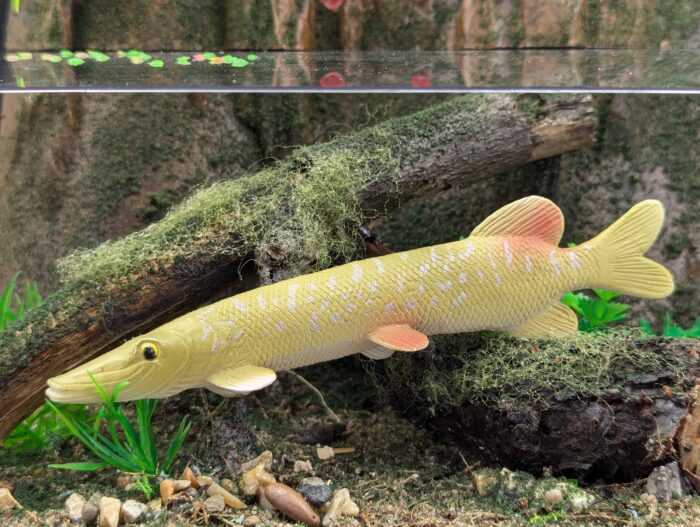
Back with another of the larger figures from Replica Toy Fish, this time the ‘six inch’ northern pike Esox lucius. This is a species that is familiar throughout a broad Holarctic range in cool waters across North America, Europe, and Russia, plus populations have been introduced in other areas as well.
Caiman (Wild Animals by Papo)
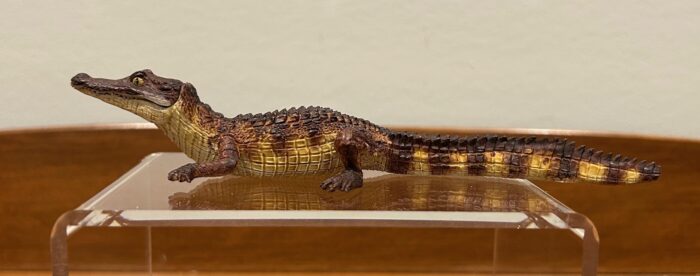
Review and images by Suspsy; edited by bmathison1972
Caimans are members of the alligator family that reside in Central and South America. There are presently six living species ranging in size from the 1.4 metre-long Cuvier’s dwarf caiman, which is the smallest living crocodilian, to the 5 metre-long black caiman, which is the largest member of Alligatoridae.
Smallmouth Bass, Brook Trout, Walleye (3 Inch Northwoods Fish Set Part 1 by Replica Toy Fish)
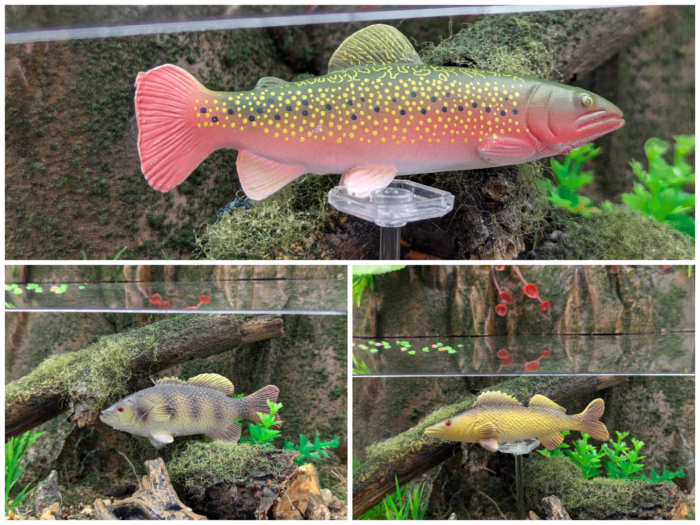
I’m back with another look at some Replica Toy Fish models. Last time was the 6″ channel catfish figure, this time I’ll be looking at one of the initial sets of three inch figures. There were two sets of six, but I will split them into two posts of three figures just to keep them a little shorter!

